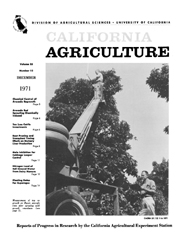All Issues








Volume 25, Number 12











|
|||
|
|||

Cover:
Measurement of top regrowth on Bacon avocado trees after spraying with growth retardants.

Cover:
Aerial view of Colusa safflower fertilizer experiment showing test laid out with seven treatments and four replications. Dark areas show improved growth of safflower over banded phosphorus (note travel of drill from one replication to another).

Cover:
Hand hedging orange trees from truck-mounted platform. Effects of training and hedging are discussed on pages 12 and 13.

Cover:
Response of Acala 4-42 cotton plants to T-1 strain of Verticillium albo-atrum
(left) - showing typical severe defoliation - and SS-4 strain (right) - showing mild symptoms typical of this wilt strain.

Cover:
Magnetic honeybee trap to right allows much greater accuracy in the evaluation of honeybee pollination activity. Bees are tagged with a tiny metal disc, allowing recapture at the hive entrnnce

Cover:
Egyptian alfalfa weevil eggs and larva below, adult to right. Progress reports of research in this issue explain the present and potential threat from this pest, as well as control possibilities through biological or chemical means, and resistant varieties.

Cover:
Benlate has been found to give excellent control of Botrytis or ‘‘fire” of Easter lily foliage in northwest California.

Cover:
“Clam shell" insect sampler developed by U.C. researchers allows absolute
insect population estimating in row crops like cotton shown here.
December 1971
Volume 25, Number 12 News and opinion |
|||
|
University of California, 1301 S. 46th St., Bldg. 478 Richmond, CA
|